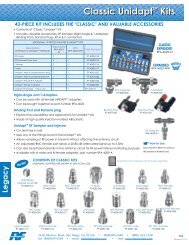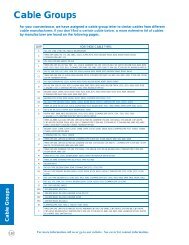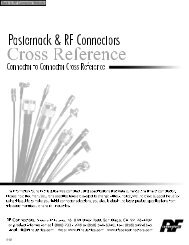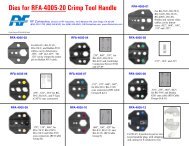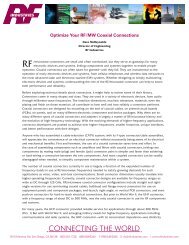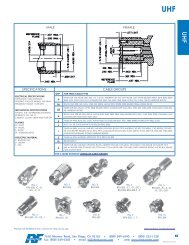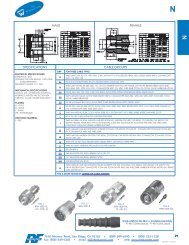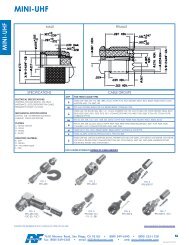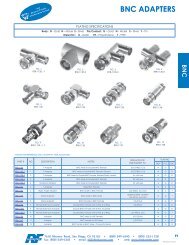RF Connectors Complete Catalog Download
RF Connectors Complete Catalog Download
RF Connectors Complete Catalog Download
You also want an ePaper? Increase the reach of your titles
YUMPU automatically turns print PDFs into web optimized ePapers that Google loves.
Crimp vs Solder<br />
CRIMP vs SOLDER: PROS & CONS<br />
Connections More Vital Than Ever<br />
Today, a flawed coaxial connection can severely reduce performance on<br />
digital systems like ThinNET (EtherNET), Wireless networks like WiFi and<br />
WLAN’s and high-end video like SDTV, DTV and HDTV. Where just a few<br />
years ago a poorly installed CCTV connector might have yielded a 1dB or<br />
less loss on a CCTV system, the same bad connection can now yield a<br />
10dB loss on a > 1GHz system. That could mean that only about a third<br />
of the signal would get through the connection.<br />
Let’s review a few of the factors to be considered when building coaxial<br />
connections and cable assemblies.<br />
First of all, whether using solder or crimp as your attachment method, you must bring the<br />
right tools and skills to the table.<br />
Good tools are not optional. The proper instruments and components, along with the knowledge gained from training and<br />
experience, set the stage for success in field and bench installations.<br />
Installing the connector’s center contact to the cable’s center conductor is more reliably achieved using either solder or crimp<br />
methods. Push-on, twist-on or wire-wrap methods can be very problematical and should not be considered for any assembly<br />
needed to perform over 1 GHz.<br />
Both crimp and solder types of connection allow for solid mechanical and electrical connections. Whichever method is used,<br />
you must practice your technique.<br />
Solder<br />
This fabrication method is often considered the most labor-intensive because the connector's center contact is soldered to the<br />
cable’s inner conductor. Performed properly, it is also one of the most reliable connections and can be used on cable with solid<br />
or stranded center conductors. If metals and plating of contact and cable are compatible and solder-able, and, if the technician<br />
is skilled in this type of installation, solder connections can be expected to perform for long periods of use.<br />
The solder method offers several advantages for connectorization.<br />
PREFERRED<br />
1. Solder around joint is smooth and shiny<br />
2. No evidence of solder flow outside joint region<br />
3. Solder hole is filled flush with outside pin surface<br />
• Tooling is simple: the main tool is a low-wattage solder iron with an assortment of tips and installation is aided by the use<br />
of a decent vise to hold the work in place while applying solder. Beyond that, the materials consumed are solder and flux.<br />
REFERENCE<br />
7610 Miramar Road, San Diego, CA 92126 • (858) 549-6340 • (800) 233-1728<br />
fax: (858) 549-6345 • email: rfi@rfindustries.com • web: www.rfindustries.com<br />
Revised 7-27-2013<br />
177



